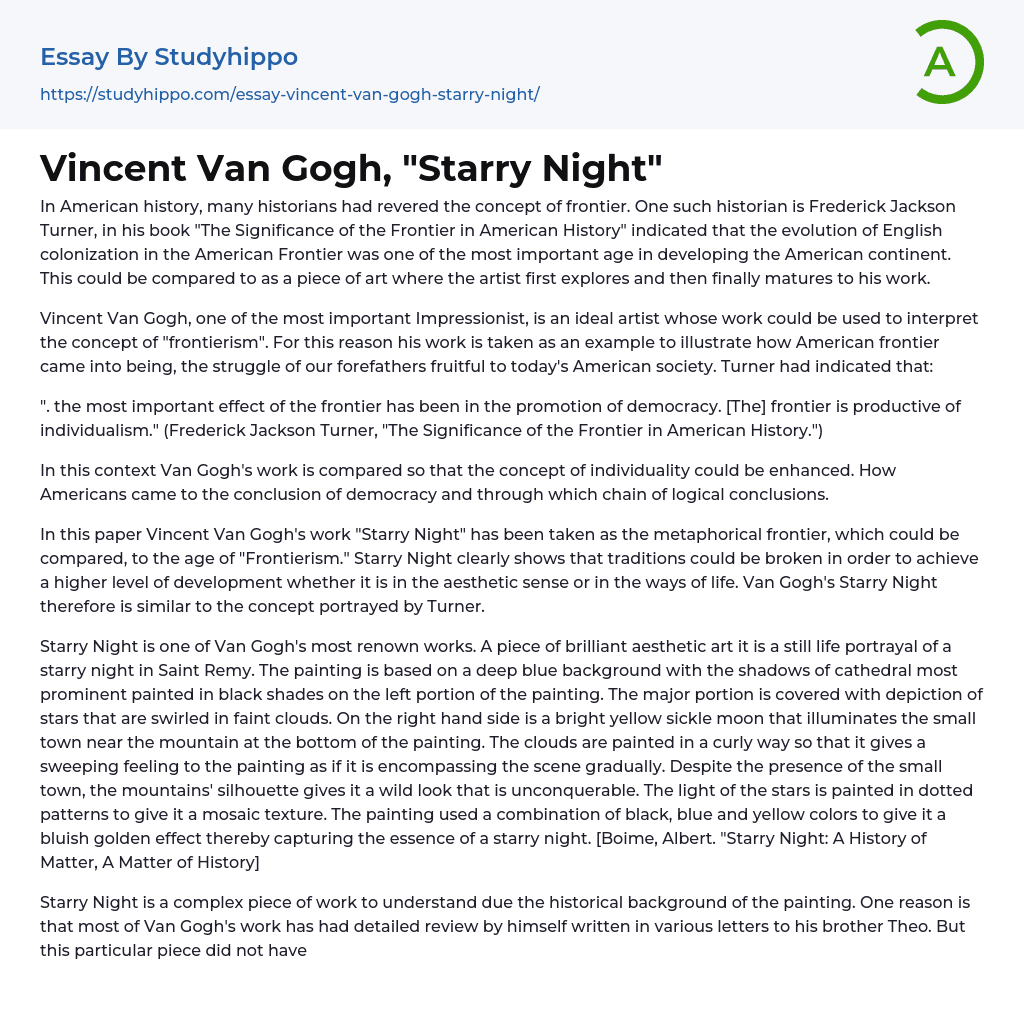Frederick Jackson Turner, in his book "The Significance of the Frontier in American History," highly esteems the concept of frontier in American history. He argues that the development of English colonization in the American Frontier played a crucial role in shaping the American continent. This can be compared to an artist who experiments and eventually perfects their work.
Vincent Van Gogh, a prominent Impressionist artist, serves as an exemplary figure for understanding the concept of "frontierism" and its application to the American experience. His work is referenced to illustrate the formation of the American frontier and the enduring legacy of the struggles faced by our ancestors in shaping modern American society. Turner's perspective on this matter is highlighted: "The most significant impact of the frontier has been in advancing democracy and fostering individualism" (Frederick Jackson
...Turner, "The Significance of the Frontier in American History").
Through this lens, Van Gogh's artistic contributions are examined to emphasize the significance of individuality. The text delves into how Americans arrived at the notion of democracy and the logical progression that led them to this conclusion.
The metaphorical frontier of Vincent Van Gogh's work "Starry Night" is compared to the age of "Frontierism". It demonstrates that traditions can be broken to attain growth in aesthetics and ways of life. Just like Turner's concept, Van Gogh's Starry Night embodies these ideas.
Starry Night, an acclaimed piece of art by Van Gogh, portrays a starry night in Saint Remy. It showcases a deep blue background with prominent black shades that depict the shadows of a cathedral on the left side. The painting features swirling stars within faint clouds and a bright yellow sickle moon on the
right side, illuminating a small town near the mountain at the bottom. The curly clouds create a sweeping effect and gradually encompass the scene. Despite the presence of the town, the silhouette of the mountains gives it an unconquerable and wild look. The stars are painted with dotted patterns, creating a mosaic texture. Through his use of black, blue, and yellow colors, Van Gogh captures the essence of a starry night with a bluish golden effect. While Starry Night lacks detailed reviews or opinions from Van Gogh himself in his letters to his brother Theo, critics and commentators form their conclusions about this painting as well as other works by Van Gogh such as "Road with Cypress and Star" and "Field of ripe wheat," which share similar themes of stars. These works reflect hidden abundance akin to America's history where true resources were not known until colonists moved westward [Elgar, Frank."Van Gogh: A study of his life and work"]. However, what sets this painting apart is its unique artistic style.Van Gogh's distinctive technique is apparent in the sweeping brushstrokes that depict the clouds and mountains. The combination of colors used is bold yet intricate, a style that sets him apart from other artists. Through this painting, Van Gogh displays his mature outlook on life. Despite his personal account stating that he was in an asylum and mentally unstable during its creation, "Starry Night" stands out due to its deviation from his other works. It clearly reflects the artist's increasing comprehension of the universe surrounding him - the arrangement of stars and moon - as well as the significance of a vast landscape juxtaposed with a
small village. The painting can also be interpreted as Van Gogh's aspiration to explore new frontiers, symbolized by the mountains. In this metaphorical sense, Van Gogh sees himself both as an expansive cloud and a pioneer striving to conquer the distant universe represented by the stars. Albert Boime's choice of subject for his painting can be understood as perceiving the world as a dark place with unattainable opportunities symbolized by the stars. In terms of American history, it can also be seen as depicting America as an untamed land with magnificent possibilities for conquest. Despite appearing unconquerable, the stars are within reach; they will always be there and can eventually be reached through understanding.
Further analysis of Boime's works reveals that the portrayal of the stars in his painting is consistent with the constellations of that era. In Nathalie Heinich's book, "The Glory of Van Gogh: An Anthropology of Admiration," she compares the use of golden coloring in Van Gogh's work to the gold rush that attracted Europeans to the continent. The golden light had a profound effect on the colonies, attracting people from all over the world. This gold mania engulfed America, and Starry Night captures this feeling through its depiction of the stars' golden light. Van Gogh's work is similar to the American frontier, challenging traditional artistic rules and conveying a sense of freedom of expression, which was his motive. Like Starry Night emerged from a psychological battle, it reveals its historical significance to any observer.




